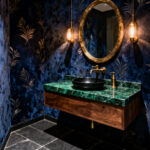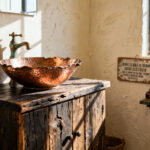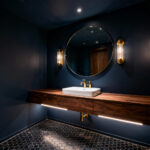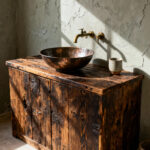Stepping into an Art Deco kitchen is like taking a journey back in time to the glitz and glamour of the roaring twenties. With its sleek geometric patterns, rich colors, and abundant details, this iconic design style continues to captivate the imagination over a century later. When thoughtfully incorporated into a kitchen design, Art Deco light fixtures can transform the space, providing beauty and function that stand the test of time.
As a designer based in the vibrant, progressive city of Boulder, I’m always seeking ways to create spaces that harmonize with nature while reflecting the latest innovations. Art Deco design encompasses these ideals. By blending elements of nature, architecture, and state-of-the-art materials and technology of the era, Art Deco creates a retro and modern look.
The unique intersection of form and function in Art Deco makes it a perfect inspiration for kitchen lighting. Art Deco offers endless options, from the practical illumination needed for cooking tasks to the style statement of a dramatic focal point fixture. This post will explore eight show-stopping Art Deco light fixtures and tips for incorporating them into your kitchen design. Just like the roaring twenties, get ready for lighting that’s full of panache!

The Allure of Geometric Chandeliers
None of the Art Deco design elements captures the imagination quite like a geometric chandelier. The interlocking shapes, symmetry, and repetitive patterns reflect the core principles of the Art Deco style. When suspended above a kitchen island or dining table, a geometric chandelier makes a bold style statement.
Materials: Chandeliers crafted from metal, glass, and crystal feature prominently in Art Deco decor. The combination of materials creates depth and dimension to catch and reflect the light. Polished metal finishes like chrome or brass paired with cut glass or crystal beads epitomize luxury.
Size: Make sure to choose a proportionate chandelier for your space. A more minor kitchen calls for a more subtle shape and size, while those with high ceilings can embrace a dramatic, grand-scale fixture. For standard 8-10 foot ceilings, plan for a chandelier with a diameter of 24-36 inches wide and a 32-48 inches height.

Impact: There may be no better way to transform a kitchen into a glamorous gathering place than by installing a geometric Art Deco chandelier. The glowing, golden light will make the space warm and inviting for casual family meals or formal dinner parties. The striking silhouette will surely spark conversation about aesthetics and the rich history behind this iconic style.
Elegant Glass Rod Sconces
Another hallmark of Art Deco design is the incorporation of glass to add a touch of sleek sophistication. Glass rod sconces epitomize this elegant aesthetic. With long cylindrical clear glass rods topped with a frosted glass shade, these sconces cast a soft, mood-enhancing glow perfect for kitchen tasks or ambient lighting.
Functionality: Thanks to their compact size, glass rod sconces fit nicely into narrow spaces in the kitchen. Install them in between upper cabinets to provide task lighting over countertops. Or flank a window over the sink to create a brighter and more welcoming workspace.
Warmth: Bulb choice is the key to creating a cozy kitchen environment with glass rod sconces. Opt for bulbs around 2700-3000K to emit a warmer, inviting glow. This light spectrum is ideal for making foods look appetizing and creating a comfortable atmosphere.

Design Cohesion: The streamlined silhouette of glass rod sconces blends seamlessly with the Art Deco style’s sleek lines and geometric shapes. For a pulled-together look, echo the cylindrical shape in metal pendants or accent lighting. The transparency of the glass ensures the sconces don’t visually compete with an ornate backsplash or boldly-colored walls.
Sophisticated Brass Pendant Lights
The warm, golden glow of brass makes it an ideal metal to incorporate into kitchen lighting. Brass pendant lights above an island or dining table provide beauty and function. As a durable, timeless metal that develops a distinguished patina over time, brass light fixtures are built to stand the test of time.
Finishes: Brass finishes range from the bright shine of polished brass to subdued satin and more green-hued antique patinas. Match the finish to your cabinet hardware and plumbing fixtures to tie the room together. Aged brass finishes pair particularly nicely with many wood species to create a well-loved vintage vibe.
Balance: Strive for balanced illumination by thoughtfully placing multiple brass pendants above surfaces where you cook, eat, or entertain. Allow 30-36 inches between each pendant to distribute light evenly. Mini-pendants mounted under upper cabinets also generate helpful task lighting.

Shape: While round and conical shapes likely come to mind first, don’t overlook geometric forms like rectangles, triangles, and trapezoids that align with the Art Deco aesthetic. Bold lines and angles contrast nicely with the soft glow of the brass.
Streamlined Flush Mount Fixtures
Kitchens with low ceilings call for flush mount fixtures that hug tightly to the ceiling without impeding headspace. Luckily, Art Deco lighting offers no shortage of options for dazzling flush mounts that still allow room to maneuver.
Patterns and Materials: From colorful stained glass to etched metal and mirrored insets, Art Deco flush mount fixtures allow you to incorporate eye-catching design details even in tight kitchen quarters. Many designs feature sunburst or starburst shapes as a nod to this quintessential Deco motif.
Choosing Lumen Output: When selecting a flush mount fixture, pay close attention to lumen output rather than simple wattage to assess the brightness. Especially in compact kitchens, you’ll want a fixture ranging from 2000-4000 lumens to provide sufficient light for food preparation and safety. Consider installing multiple flush mount fixtures to distribute illumination evenly throughout the space.

Energy Efficiency: Thanks to advances in LED bulb technology, many flush-mount Art Deco fixtures now feature energy-efficient lighting. Choosing an EnergyStar-rated fixture can provide years of beauty without raising big energy bills. Just ensure the light color doesn’t skew too blue or give a “clinical” feeling for the warm, welcoming kitchen environment you seek.
Globe Pendants – Simplicity Meets Style
Sometimes, the most straightforward light fixtures make the most dramatic impact. As the name implies, Globe pendants feature a round, spherical shade. While the shape may be essential, spectacular Art Deco-inspired globe pendants come in dazzling colors, bold patterns, and eye-catching materials like multi-colored glass or faceted crystal.
Arrangements: Hang a single, oversized globe pendant above a kitchen island or dining table as a glowing focal point. Or explore mixing multiple small-scale pendants in a linear row or cluster to increase visual interest.
Bulb Choice: Pay careful attention to bulb choice within globe pendants. Opt for filament-style Edison bulbs or tubular halogen bulbs to emit a welcoming golden glow. You can also play up the Deco drama by selecting a colored bulb that coordinates with the pendant shade or kitchen color scheme.

Focal Point: Thanks to their spherical shape that catches and reflects light from all angles, Art Deco-style globe pendants inherently draw the eye, making them natural focal points. Embrace their attention-grabbing talents by selecting a pendant with an extra pizzazz. Try a bold color like sapphire blue or an eye-popping pattern for a dazzling fixture.
Sleek Linear Suspension Lighting
While many Art Deco light fixtures focus on circular shapes and radial symmetry, linear suspension fixtures display the style’s other geometric side. Defined by their horizontal solid lines and rectilinear form, these long, narrow pendant lights feel strikingly modern for a 1920s-born style.
Task Lighting: Position linear suspension lighting directly over kitchen islands, bars, and peninsula counters to provide excellent task lighting. Specify the pendant length to equal or exceed the width of the underlying surface for optimal illumination.
Multi-light Options: Take full advantage of the elongated form factor by selecting a linear suspension light with multiple integrated light sources. Models with 3, 4, or 5 individual bulbs allow you to illuminate a larger surface area while maintaining the same sleek shape.

Controls: Add dimmer switches or intelligent bulbs to make these fixtures work overtime. That way, you can adjust the brightness for ambient lighting or spotlighting for intricate cooking tasks. Turn down the lights for an intimate meal or crank them to full power for party prep mode. The choice is yours!
Sculptural Uplighting
Most often utilized in public and commercial spaces, uplighting offers an infinitely artistic way to illuminate architectural details in the home. Uplights cast light from below to emphasize textural elements on walls and ceilings. This makes them an excellent choice for highlighting the moldings, medallions, and decorative plasterwork in many Art Deco spaces.
Strategic Placement: Consider uplighting above kitchen cabinets to accentuate the moldings and add depth. The ambient glow makes a lovely backdrop for displaying cherished glassware or dinnerware. For kitchen islands topped with a decorative corbel-style overhang, uplights on top of the island can create striking shadows and dimension.
Enhance Architecture: You can also use uplighting to spotlight arched doorways, the domed shape of a glass pendant light, or the stepped form of a geometric Art Deco backsplash. Wherever you have distinctive architectural details, uplighting allows you to celebrate these designs after dark. The result feels both glamorous and moody.

Mood Lighting: Uplighting casts a diffuse, ambient glow ideal for setting a relaxing or romantic kitchen mood. Dim the lights low and pour a glass of wine for an effortlessly elegant Art Deco evening.
Vintage-Inspired Lanterns
Art Deco design draws heavily from historical influences, from Egyptian motifs to Neoclassical architecture. Bringing lanterns into an Art Deco kitchen is a charming way to acknowledge this connection to the past while putting a modern spin on a familiar fixture. Vintage-inspired lanterns feel fresh and current while paying homage to the early 20th-century obsession with nostalgia.
Mix Old and New: While too many historic references could make a kitchen feel dated, thoughtfully mixing a few vital antique elements with sleek modern finishes keeps the look feeling fresh and innovative—pair metal or glass lanterns with streamlined European-style cabinetry and sparkling quartzite countertops to strike the right balance.
Light Output:
- Don’t sacrifice function for style.
- Select lanterns that throw off sufficient illumination for typical kitchen tasks.
- Give preference to lanterns with transparent glass panels rather than opaque materials that could block too much light.

Lanterns as Accents: In addition to installing lanterns as primary light fixtures, you can incorporate more miniature lanterns as decorative accents. A mini lantern displayed on a kitchen island, windowsill, or shelf injects vintage character without competing with existing lighting. Use battery-operated candles to create an ambiance without wires.
Conclusion: Embrace the Allure of Art Deco Lighting
Art Deco lighting radiates glamour and sophistication with a timeless appeal like a shining jewel from decades past. Art Deco strikes an ideal balance for contemporary kitchen spaces with geometric angles that feel freshly modern yet pay homage to beloved design history.
Much like Art Deco masters of the past, view lighting selection as an opportunity to blend beauty, function, and the latest technology available. Whether you gravitate toward the sleek lines of linear pendants, the warm minimalism of brass fixtures, or the unabashed decadence of a crystal chandelier, let Art Deco lighting transport your kitchen back to the golden era of exquisite style.

Frequently Asked Questions
What are the key characteristics of Art Deco lighting fixtures?
Some hallmarks of Art Deco lighting include geometric shapes, rich colors like emerald, sapphire, and ruby hues, luxurious materials such as crystal and metals, and details like symmetrical patterns, chrome or brass accents, and glass panels or beads.
What types of kitchens work well with Art Deco lighting?
Art Deco lighting can complement both traditional and contemporary kitchen styles. The bold colors and striking shapes create drama and sophistication from classic to modern spaces. For those wanting to recreate an authentic 1920s-30s aesthetic, Art Deco elements like zigzag tile and cherry cabinetry work seamlessly with period lighting.
How do I incorporate Art Deco lighting with other kitchen finishes?
Look for opportunities to echo shapes, metals, and colors used in your Art Deco light fixtures. For example, barstools or a kitchen island with a chrome base coordinate nicely with the sleek metal finishes found in many Art Deco-inspired pendants and sconces. Use cabinetry, quartzite countertops, or glass tile backsplash in similar jewel-toned colors to create a cohesive palette.
Where should I position Art Deco lighting in my kitchen?
Focus on lighting task zones first where illumination is needed, like the sinks, stoves, islands, and dining areas above. From there, consider adding accent lighting such as uplights or glass sconces to create ambiance and draw attention to unique architectural details or display areas. Finally, don’t be afraid to have some fun by incorporating a bold geometric chandelier or grouping of pendants as a dramatic focal point.






